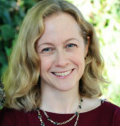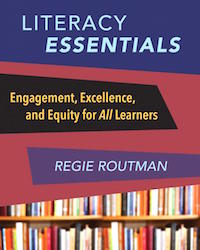“It’s Like Having Coffee with a Master Teacher”
Literacy Essentials: Engagement, Excellence, and Equity for All Learners
By Regie Routman
(Stenhouse Publishers, 2018 – Learn more)

Leafing through Regie Routman’s Literacy Essentials feels not so much like reading a book as like having coffee with a master teacher, or maybe wading in and out of a calm ocean.
As many reviewers have said, it’s a long book, but it’s long because it’s a compendium of wisdom about teaching and about life.
There are so many ways to approach Literacy Essentials:
- Read a section that sounds interesting, such as “Make sure students are engaged, not just on-task,” “Be more intentional” or “Build stamina and the will to learn.” Then reflect on how this idea already appears or how you would like it to appear in your classroom daily.
- Take one of the book’s excellent charts, such as “Frontloading Possibilities” (130), and apply it to a unit you’d like to deepen.
- After reading one of Routman’s many touching stories, write a story about your own experience, in your classroom or beyond. Share your writing, no matter if it’s short or rough, with a family member or colleague to open up a conversation about how we learn and how we teach. Routman encourages all teachers to write, quoting Donald Murray as saying, “No writing is ever wasted” and “Never a day without a line” (127).
- Follow one of the scads of research-saturated footnotes to discover a new article or book you’d like to check out.
- Join a community of educators talking about Literacy Essentials in this summer’s wide-ranging Stenhouse Book Club.

For me, this book’s greatest inspirations came in two categories:
- What’s best for our kids?
- What’s best for us as their teachers?
What’s Best for Our Students
Every page of this book focuses on how all students can learn. Here are two takeaways I especially loved.
- Make sure we are assigning what’s best for kids.
Throughout the book, Routman urges us to focus more on depth than coverage, more on working through than getting done, more on explicit understandings than implicit assumptions. These concepts can take so many forms, including research questions, public writing conferences or the intentional transfer of an author’s style to a student’s draft.
A few questions highlighted the need for focused, quality projects and papers:
- “Do we really need to have long writing projects, which place high demands on us for conferring, revising, and editing; or can we teach what students need to know with shorter assignments?”
- “Are the projects and management we are creating for students worth the time and effort they take? Can we simplify those and still maintain high quality? Is the students’ dependence on us sapping our energy and joy?” (35)
Similarly, Routman suggests questions to make writing meaningful, ones I plan to apply to a Civil War essay/documentary project in the fall:
- “How can we make the work and audience for the writing so authentic and personal that students will invest their best efforts and will remember the experience, even as adults?”
- “How can our work give students agency and purpose in their lives?”
- “What kind of frontloading will be necessary so students know the content well enough to interpret it and apply it with minimal support?” (88)
- Be flexible and devoted, both in planning and in the moment.
Routman is always aware of student responses to lessons and is willing to change things up right away if her first approach isn’t panning out.
I am planning to laminate the following quotation about “urgent teaching” and put it next to my desk, because it asks us to constantly assess what our students are learning:
Teaching with a sense of urgency means focusing relentlessly on what’s most important throughout every single day, moving at an efficient and effective steady pace, seizing problems and failure as opportunities for growth, and changing course as needed… making every minute count. That may mean abandoning a lesson or an action, even though it’s written in our plan book, if it’s not working” (55).
Routman also asks us to use our minutes well, to “carefully self-monitor how precious time is used.” She admits that “I’m a clock watcher when I teach” (58).
This reminded me of a story from my own first year of teaching. Every night I called my mom, Jane Schaffer, a master English teacher herself, to ask her for feedback on the next day’s lesson plans. One of her first questions was always: “How many minutes will that take?” Even today, when I feel a class period went off the rails, it’s often because I let an activity go too long.
What’s Best for Us
One of the most refreshing elements of this book appears in its encouraging teachers to take care of themselves as human beings. In its tone, it reminded me of some of the loveliest self-care teaching books I’ve read, such as Donald H. Graves’ The Energy to Teach and Parker J. Palmer’s The Courage to Teach.
- Make teaching personal and joyful.
Routman asserts that we will find more in our students – and ourselves – when we bring the personal into the classroom: “Make personal stories and storytelling central to your classroom and school’s speaking, listening, and writing culture and community” (77).
She also focuses on joy as our bottom line, not simply with our students but also and especially with our fellow adults on campus. As she notes, “we have greater opportunities for growth when we can freely and joyfully collaborate with colleagues” (10).
Within such overarching themes, Routman includes nuggets of practical brilliance, such as this advice for on-the-ground administrators: “Savvy principals occasionally take over classrooms for an hour and serve as a substitute teacher to promote collaboration among and between teachers” (109).
- Take care of yourself and fuel your passions.
I laughed out loud when I started reading a section titled “Live an interesting life,” in which Routman admits: “Years ago I was in danger of becoming a very boring person. Most of my time outside of work was spent reading and studying educational issues… When we have interesting stories to tell and new ideas and burning questions to share, we enter our classrooms with a sense of rejuvenation and wonder” (60). This entire section is another one I’d like to print out in large font and laminate!
Routman’s emphasis on exploring the world beyond the classroom also reminds me of another book I’ve read recently, Julia Cameron’s classic The Artist’s Way. Cameron suggests making a two-hour solo “artist’s date” with yourself every week, which can be something as simple as taking a nature walk or something as elaborate as seeing a play. On the weeks I carve out time to do this, I can feel the rest of my life – and my teaching – buzz with the aftereffects of seeking out beauty and inspiration.
Routman also includes welcome reminders of the need to stop grading, planning, working at some point, as with this one italicized later in the book, in a section called “Read and Write More Texts”: “If we are able to assess all the pages students read and write, they’re not reading and writing enough” (174). Amen.
Start Now
If you have this book at home and are daunted by the length (as I was, for months – I admit!), just start anywhere that interests you. Even five pages at a time will fill you up and drive you to tweak something for the better, for you or for your students.
Toward the end Routman observes that, through her years working with teachers in classrooms, those who watch her modeling a lesson “see what their students are capable of, which causes the ‘yes buts’ to disappear” (263). I like to think that I’m a relentless self-assessor as a teacher, but quotations such as these made me believe I can do still more, for my students and for myself.
Sarah Cooper teaches eighth-grade U.S. history and is dean of studies at Flintridge Preparatory School in La Canada, California, where she has also taught English Language Arts. She is the author of Making History Mine (Stenhouse, 2009) and Creating Citizens: Teaching Civics and Current Events in the History Classroom (Routledge/MiddleWeb, 2017). She presents at conferences and writes for a variety of educational sites. You can find all of Sarah’s writing at sarahjcooper.com.


































